



Starting to reach middle-innings in this series, as we wind-up the 1940’s. The decade had been reasonably prolific in producing baseball-themed features which provided good box office receipts, including “The Pride of the Yankees” early in the decade, and in its later half “The Babe Ruth Story”, “It Happens Every Spring”. “The Stratton Story”, and the Gene Kelly/Frank Sinatra musical, “Take Me Out To the Ball Game”. As the war shortage of manpower ended, Baseball became even more popular, such that animation attempted to keep pace with the current trends – including, as discussed below, the rising popularity of a rival league in an adjoining land. Several one-shot cartoons take their single at-bats today, while recurring stars Little Lulu, Gandy Goose, Woody Woodpecker, Donald Duck, and Bugs Bunny maintain their positions in the rotation.
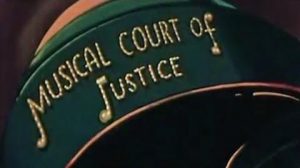 Musicalulu (erroneously retitled “Musical Lulu” on all U. M. & M. TV reprints) (Famous/Paramount, Little Lulu, 1/24/47 – I. Sparber, dir.) – Lulu is torn between the boredom of practicing her violin lessons, and a baseball game being organized by Tubby outside. Knowing her father expects her to practice for a good half hour yet, she solves the problem by subterfuge – tying the violin bow to the tail of her dog, and giving him a bone so that his tail wags the bow across the violin strings. Lulu plays outfield in the game, but a fly ball catches in the rain gutter of the house, then unexpectedly conks Lulu on the head. Amidst a spiral of stars, Lulu is transported to a surreal world of living musical instruments, where a bass drum “cop” places her in handcuffs and hauls her off to the Musical Court of Justice (housed in a giant juke box). There, before a jury of 8 violins in a jury box made of a grand piano, she is placed on trial for desertion of her instrument. A prosecuting attorney (a clarinet) presents his case before a bass fiddle judge, sitting at a conductor’s podium on a kettle drum chair. A court reporter (a harmonica) takes down “notes” in shorthand on music sheets. The prosecutor presents compelling evidence – Lulu’s violin, displaying broken strings, and Lulu’s incriminating name carved with a penknife into her backside. Lulu tries her own influence on the jury – making distorted faces at the prosecutor through a bubble blown with bubble gum, displaying a bare “rubber hose” feminine leg at the jury (causing them to react “Woo Woo”), and slingshooting a cork into the prosecutor’s “bell” opening, temporarily silencing him. But the final blow comes when the prosecutor produces a surprise corroborating witness, who claims to have seen the whole thing. Lulu denounces him: “He’s a lyre – an awful lyre!” But to no avail, as the violins unanimously hold up their bows in a verdict of “Guilty!!!”, the bows mirroring the prison bars Lulu will soon be behind.
Musicalulu (erroneously retitled “Musical Lulu” on all U. M. & M. TV reprints) (Famous/Paramount, Little Lulu, 1/24/47 – I. Sparber, dir.) – Lulu is torn between the boredom of practicing her violin lessons, and a baseball game being organized by Tubby outside. Knowing her father expects her to practice for a good half hour yet, she solves the problem by subterfuge – tying the violin bow to the tail of her dog, and giving him a bone so that his tail wags the bow across the violin strings. Lulu plays outfield in the game, but a fly ball catches in the rain gutter of the house, then unexpectedly conks Lulu on the head. Amidst a spiral of stars, Lulu is transported to a surreal world of living musical instruments, where a bass drum “cop” places her in handcuffs and hauls her off to the Musical Court of Justice (housed in a giant juke box). There, before a jury of 8 violins in a jury box made of a grand piano, she is placed on trial for desertion of her instrument. A prosecuting attorney (a clarinet) presents his case before a bass fiddle judge, sitting at a conductor’s podium on a kettle drum chair. A court reporter (a harmonica) takes down “notes” in shorthand on music sheets. The prosecutor presents compelling evidence – Lulu’s violin, displaying broken strings, and Lulu’s incriminating name carved with a penknife into her backside. Lulu tries her own influence on the jury – making distorted faces at the prosecutor through a bubble blown with bubble gum, displaying a bare “rubber hose” feminine leg at the jury (causing them to react “Woo Woo”), and slingshooting a cork into the prosecutor’s “bell” opening, temporarily silencing him. But the final blow comes when the prosecutor produces a surprise corroborating witness, who claims to have seen the whole thing. Lulu denounces him: “He’s a lyre – an awful lyre!” But to no avail, as the violins unanimously hold up their bows in a verdict of “Guilty!!!”, the bows mirroring the prison bars Lulu will soon be behind.
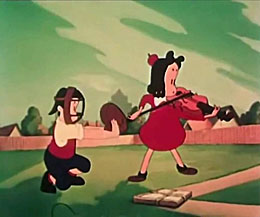 Lulu’s attempts a jail break. Imprisoned in a large guitar with the six strings as bars, she stretches two of the strings backward, and is catapulted free out the sound hole. But her nightmare has just begun, as a quartet of quarter notes block her path, and taunt her with an original song, “You Gotta Have Music”. A fantasy chase ensues, with Lulu pursued across a giant piano keyboard, nearly crushed by huge cymbals, snapped at by a serpentine concertina, blown skyward by a chorus of trumpets, and finally ensnared in harp strings like a spider’s web. The scene spirals, as Lulu returns to consciousness and the real world, as her teammates gather around her, asking “How’s your head?”. Thinking better of abandoning her violin, Lulu races into the house and retrieves it from her dog’s tail. But clever Lulu devises a solution to obtain the best of both worlds. She practices her lesson – but on the baseball diamond, using the instrument as her custom bat to sock a homer between cadenzas.
Lulu’s attempts a jail break. Imprisoned in a large guitar with the six strings as bars, she stretches two of the strings backward, and is catapulted free out the sound hole. But her nightmare has just begun, as a quartet of quarter notes block her path, and taunt her with an original song, “You Gotta Have Music”. A fantasy chase ensues, with Lulu pursued across a giant piano keyboard, nearly crushed by huge cymbals, snapped at by a serpentine concertina, blown skyward by a chorus of trumpets, and finally ensnared in harp strings like a spider’s web. The scene spirals, as Lulu returns to consciousness and the real world, as her teammates gather around her, asking “How’s your head?”. Thinking better of abandoning her violin, Lulu races into the house and retrieves it from her dog’s tail. But clever Lulu devises a solution to obtain the best of both worlds. She practices her lesson – but on the baseball diamond, using the instrument as her custom bat to sock a homer between cadenzas.
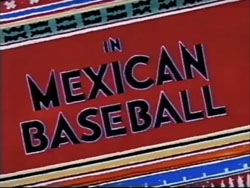 Mexican Baseball (Terrytoons/Fox, Gandy Goose, 3/14/47 – Mannie Davis, dir.) – The Mexican League, founded in 1925, grew in visibility and popularity during post-WWII by luring players away from American major leagues. This, this cartoon was a topical item at time of production. The two major leaguers lured to play are Gandy and Sourpuss, who arrive in an old jalopy at the entrance to a bull ring converted into a baseball stadium. They present themselves as a two-man visiting team, while a Mexican band plays a slightly off-key rendition of “Yankee Doodle”. Then the home team is introduced, as gates across the arena open – releasing a stampede of charging bulls, dressed in baseball uniforms. Gandy and Sourpuss are driven waist-deep into the ground as the bulls charge over them, then watch as the bulls mix it up with tosses of baseballs along the baselines and outfield. Gandy remarks to Sourpuss, “On second thought, I think I’ll go home.” Sourpuss (played in this one cartoon by Paramount regular Sid Raymond), angrily responds. “Listen. You’re in this as deep as I am. I’m gonna see this through, even if it costs me YOUR life!”
Mexican Baseball (Terrytoons/Fox, Gandy Goose, 3/14/47 – Mannie Davis, dir.) – The Mexican League, founded in 1925, grew in visibility and popularity during post-WWII by luring players away from American major leagues. This, this cartoon was a topical item at time of production. The two major leaguers lured to play are Gandy and Sourpuss, who arrive in an old jalopy at the entrance to a bull ring converted into a baseball stadium. They present themselves as a two-man visiting team, while a Mexican band plays a slightly off-key rendition of “Yankee Doodle”. Then the home team is introduced, as gates across the arena open – releasing a stampede of charging bulls, dressed in baseball uniforms. Gandy and Sourpuss are driven waist-deep into the ground as the bulls charge over them, then watch as the bulls mix it up with tosses of baseballs along the baselines and outfield. Gandy remarks to Sourpuss, “On second thought, I think I’ll go home.” Sourpuss (played in this one cartoon by Paramount regular Sid Raymond), angrily responds. “Listen. You’re in this as deep as I am. I’m gonna see this through, even if it costs me YOUR life!”
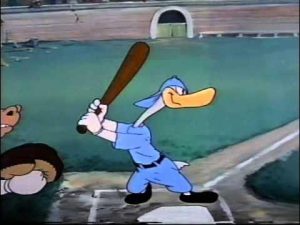 Gandy struts to the plate, but rolls himself there the second half of the way, slipping upon a continuous row of bats placed on the ground up to home plate. A bull catcher pucks Gandy up, and uses him for a whisk broom to dust off the plate. The pitcher’s first pitch is so powerful as to knock even a bull catcher to the backstop (for once, not accompanied by endless chatter from the dazed catcher). Gandy gets a bat upon the second pitch, and races around first. But the ball is tossed to the second baseman, and the old pickle-play is revisited again. A change of pay-off gag, as Gandy reverses directions so any times in running between first and second, his feet dig a trench into the ground, and Gandy disappears within. As the second baseman looks down into the trench for him, Gandy pops out of the ground behind him, and kicks the baseman into the hole. Gandy heads for second, and the first baseman tosses the ball after him. Gandy rounds the bags, with the ball in close pursuit, changing directions at each corner to match his step. Sid Raymond performs his track-announcer voice from a racetrack, calling the race between player and ball as coming into the home stretch neck and neck. Gandy slides while the catcher waits to receive the ball at home. Gandy’s slide takes him between the waiting bull’s legs, and he seizes the plate, ripping it from the ground and taking it with him nearly to the backstop, beating the tag. First run for the Americanos, with the band playing another refrain of “Yankee Doodle”.
Gandy struts to the plate, but rolls himself there the second half of the way, slipping upon a continuous row of bats placed on the ground up to home plate. A bull catcher pucks Gandy up, and uses him for a whisk broom to dust off the plate. The pitcher’s first pitch is so powerful as to knock even a bull catcher to the backstop (for once, not accompanied by endless chatter from the dazed catcher). Gandy gets a bat upon the second pitch, and races around first. But the ball is tossed to the second baseman, and the old pickle-play is revisited again. A change of pay-off gag, as Gandy reverses directions so any times in running between first and second, his feet dig a trench into the ground, and Gandy disappears within. As the second baseman looks down into the trench for him, Gandy pops out of the ground behind him, and kicks the baseman into the hole. Gandy heads for second, and the first baseman tosses the ball after him. Gandy rounds the bags, with the ball in close pursuit, changing directions at each corner to match his step. Sid Raymond performs his track-announcer voice from a racetrack, calling the race between player and ball as coming into the home stretch neck and neck. Gandy slides while the catcher waits to receive the ball at home. Gandy’s slide takes him between the waiting bull’s legs, and he seizes the plate, ripping it from the ground and taking it with him nearly to the backstop, beating the tag. First run for the Americanos, with the band playing another refrain of “Yankee Doodle”.
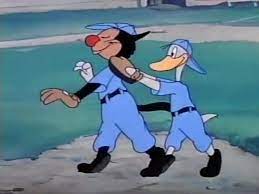 Now, Sourpuss’s turn. The pitcher tries one which should probably have been called a ball anyway – leaping high into the air off the mound, and launching a high-altitude slow ball. But Sourpuss turns it into a hit, acquiring a step-ladder to stand upon as he swings. The ball is hit straight up, and makes a pass over the crescent moon (lifting a gag from the studio’s own “Barnyard Baseball”). In close parallel to Goofy’s “How to Play Baseball”, four bulls converge in the infield with shouts of “I got it”, slamming into one another and knocking each other cold, while the ball lands untouched between their four sets of feet. Sourpuss dances unopposed around the bases to the crowd’s cheers, but has some of the grandeur of hus scoring at home taken away as he trips over a water bucket after crossing the plate, depositing the pail atop Gandy’s head.
Now, Sourpuss’s turn. The pitcher tries one which should probably have been called a ball anyway – leaping high into the air off the mound, and launching a high-altitude slow ball. But Sourpuss turns it into a hit, acquiring a step-ladder to stand upon as he swings. The ball is hit straight up, and makes a pass over the crescent moon (lifting a gag from the studio’s own “Barnyard Baseball”). In close parallel to Goofy’s “How to Play Baseball”, four bulls converge in the infield with shouts of “I got it”, slamming into one another and knocking each other cold, while the ball lands untouched between their four sets of feet. Sourpuss dances unopposed around the bases to the crowd’s cheers, but has some of the grandeur of hus scoring at home taken away as he trips over a water bucket after crossing the plate, depositing the pail atop Gandy’s head.
Gandy returns for another at bat. The bulls prepare a sabotage, loading the ball with Mexican jumping beans. The pitch jerks up and down, back and forth in all directions as it approaches the plate. But Gandy is sharp-eyed, and keeps up with it, giving the ball a clout. The strategy backfires on the bulls, as their fielders can’t seem to lay a glove upon the perpetually bouncing ball, and Gandy scores again.
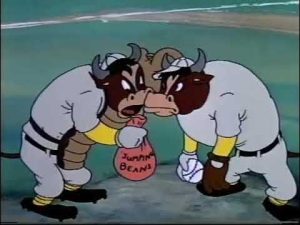 A montage of shots shows Gandy and Sourpuss continuing to score, inning after inning, until the bottom of the ninth, with the bulls behind 21 to zero. Sourpuss pitches, while Gandy acts as catcher. Though the bull at bat carries six bats, Sourpuss’s spinner makes short work of them, sawing all of them in half. Gandy imitates the catcher in Avery’s “Batty Baseball”, darting out in front of the bull repeatedly to catch the ball. The bull picks Gandy up by the hat, deposits him back behind him, then hammers with his bat upon Gandy’s head, to drive and root Gandy’s feet firmly in the ground. Sourpuss’s fireball does the usual of burning the bull’s new bat into a matchstick, a la Goofy. In a clever new original gag, Sourpuss’s third pitch stops in mid-air just before the mound, and a small mechanical hand pops out of the ball, waving a red cape in front of the bull’s eyes. The angered bull still manages to hit it, and charges around the bases on all fours. But Gandy, still remembering that loose concrete slab at home plate, pills a fast one – driving his shoe spikes into the plate, then hopping into the air as the bull approaches, taking the plate with him. Gandy and the plate land on the sliding bull’s back, and Gandy tags the bull out with the ball. The band again starts playing “Yankee Doodle”, but the bulls’ team captain appears at the bandstand, yelling “Silencio”. The bandleader pauses, and listens as the bull whispers a suggestion into his ear. “Ah, si si!”, responds the bandleader, and with a tap of his baton, signals the band for a change of mood. They break into a spirited conga rhythm. The bulls are into this kind of music, and begin dancing around as they approach the plate. Even Gandy finds himself taken by the rhythm, and starts to do a few steps himself behind the plate. With swiveling hips, the bull batter delivers a mighty blow to Sourpuss‘s first pitch, and congas his way toward first. Without even waiting for the batter to reach base, another bull comes up to bat, repeating the hit of the first. One bull after another repeats the action, each of them linking an arm to the shoulder of the runner ahead of them as they proceed down the line. Soon, the entire diamond is lined with conga-dancing bulls, making hit after hit. A close shot shows us Gandy and Sourpuss on the mound, now completely caught up in the spirit, and conga-dancing together. “Who’s winning?”. asks Gandy. ‘Who cares?”, replies Sourpuss, “We’re having fun.” The dance continues endlessly to the crowd’s cheers, as we fade out.
A montage of shots shows Gandy and Sourpuss continuing to score, inning after inning, until the bottom of the ninth, with the bulls behind 21 to zero. Sourpuss pitches, while Gandy acts as catcher. Though the bull at bat carries six bats, Sourpuss’s spinner makes short work of them, sawing all of them in half. Gandy imitates the catcher in Avery’s “Batty Baseball”, darting out in front of the bull repeatedly to catch the ball. The bull picks Gandy up by the hat, deposits him back behind him, then hammers with his bat upon Gandy’s head, to drive and root Gandy’s feet firmly in the ground. Sourpuss’s fireball does the usual of burning the bull’s new bat into a matchstick, a la Goofy. In a clever new original gag, Sourpuss’s third pitch stops in mid-air just before the mound, and a small mechanical hand pops out of the ball, waving a red cape in front of the bull’s eyes. The angered bull still manages to hit it, and charges around the bases on all fours. But Gandy, still remembering that loose concrete slab at home plate, pills a fast one – driving his shoe spikes into the plate, then hopping into the air as the bull approaches, taking the plate with him. Gandy and the plate land on the sliding bull’s back, and Gandy tags the bull out with the ball. The band again starts playing “Yankee Doodle”, but the bulls’ team captain appears at the bandstand, yelling “Silencio”. The bandleader pauses, and listens as the bull whispers a suggestion into his ear. “Ah, si si!”, responds the bandleader, and with a tap of his baton, signals the band for a change of mood. They break into a spirited conga rhythm. The bulls are into this kind of music, and begin dancing around as they approach the plate. Even Gandy finds himself taken by the rhythm, and starts to do a few steps himself behind the plate. With swiveling hips, the bull batter delivers a mighty blow to Sourpuss‘s first pitch, and congas his way toward first. Without even waiting for the batter to reach base, another bull comes up to bat, repeating the hit of the first. One bull after another repeats the action, each of them linking an arm to the shoulder of the runner ahead of them as they proceed down the line. Soon, the entire diamond is lined with conga-dancing bulls, making hit after hit. A close shot shows us Gandy and Sourpuss on the mound, now completely caught up in the spirit, and conga-dancing together. “Who’s winning?”. asks Gandy. ‘Who cares?”, replies Sourpuss, “We’re having fun.” The dance continues endlessly to the crowd’s cheers, as we fade out.
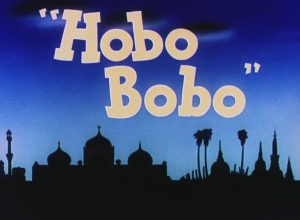 Hobo Bobo (Warner, 5/17/47 – Robert McKimson, dir.) – In India, a little elephant named Bobo is burdened with the daily task of carrying small logs for his masters. He realizes that all that exists in his foreseeable future is to grow larger, and be burdened with carrying bigger and bigger logs. and thus, gazing into a crystal ball, all he foresees a “dark” future, in the form of an 8-ball. However, he receives a photograph in the mail from his uncle in New York, who is performing with a circus, showing him playing on a circus baseball team. Bobo decides that the circus is the life for him, escapes his owners, and attempts to board a ship bound for New York. He is immediately thrown off, the ship refusing to take on an elephant. Numerous attempts to board the ship fail miserably. However, Bobo receives some friendly advice from a Minah Bird – guest cameoing from Chuck Jones’s Inki cartoons. Simply paint yourself pink. Bobo has no idea why this should work, but the savvy bird knows that no one will admit to seeing a pink elephant.
Hobo Bobo (Warner, 5/17/47 – Robert McKimson, dir.) – In India, a little elephant named Bobo is burdened with the daily task of carrying small logs for his masters. He realizes that all that exists in his foreseeable future is to grow larger, and be burdened with carrying bigger and bigger logs. and thus, gazing into a crystal ball, all he foresees a “dark” future, in the form of an 8-ball. However, he receives a photograph in the mail from his uncle in New York, who is performing with a circus, showing him playing on a circus baseball team. Bobo decides that the circus is the life for him, escapes his owners, and attempts to board a ship bound for New York. He is immediately thrown off, the ship refusing to take on an elephant. Numerous attempts to board the ship fail miserably. However, Bobo receives some friendly advice from a Minah Bird – guest cameoing from Chuck Jones’s Inki cartoons. Simply paint yourself pink. Bobo has no idea why this should work, but the savvy bird knows that no one will admit to seeing a pink elephant.
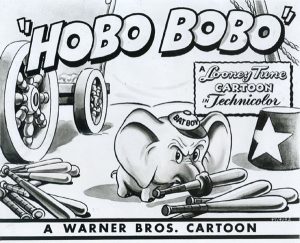 Bobo thus climbs the gangplank, right past the purser’s nose, without opposition – as the man reveals a hidden bottle under a pier post, which he kicks away into the sea. Bobo obtains the run of the ship, able to roam the decks right past the tourists, although he is a bit upset that no one will be friends with him. He even meets the captain, and “takes a turn at the wheel” with his trunk on the bridge, while the captain, careful not to let others see, tries to pull the wheel back under his command. Finally, the ship reaches New York – “the land of the free, the home of the Braves, the Dodgers, the Yankees…” – where Bobo is again upset that his trunk is the only one which will the customs agents will not inspect. Bobo becomes lost and isolated in the big city, as no one, not even traffic cops, will give him directions to the circus, all continuing to treat him as invisible. He sits down upon a sidewalk curb to bemoan his poor luck, when a water wagon passes to clean the streets. Bobo is splashed with water, which washes off his coat of pink. Oh, the humiliation, thinks Bobo. But suddenly, he is the center of attention. A grey elephant, loose in the big city! Police are called in, and Bobo is handcuffed and placed under arrest (another devastating humiliation). He is brought before a judge, and hears whispers of talk of something called “the chair”. The judge pronounces sentence upon him of “life” – in the circus. The narrator sums up Bobo’s reaction with the phrase “Why, that’s the answer to the $64 question” (reference to a radio quiz show of the same name). Bobo makes good, not only becoming part of the circus, but even a member of its baseball team. He is now the official bat boy. In his only line of dialogue in the film, Bobo delivers curtain line to the audience, a la Lou Costello: “Bat boy, schmat boy! I’m still carrying logs!”
Bobo thus climbs the gangplank, right past the purser’s nose, without opposition – as the man reveals a hidden bottle under a pier post, which he kicks away into the sea. Bobo obtains the run of the ship, able to roam the decks right past the tourists, although he is a bit upset that no one will be friends with him. He even meets the captain, and “takes a turn at the wheel” with his trunk on the bridge, while the captain, careful not to let others see, tries to pull the wheel back under his command. Finally, the ship reaches New York – “the land of the free, the home of the Braves, the Dodgers, the Yankees…” – where Bobo is again upset that his trunk is the only one which will the customs agents will not inspect. Bobo becomes lost and isolated in the big city, as no one, not even traffic cops, will give him directions to the circus, all continuing to treat him as invisible. He sits down upon a sidewalk curb to bemoan his poor luck, when a water wagon passes to clean the streets. Bobo is splashed with water, which washes off his coat of pink. Oh, the humiliation, thinks Bobo. But suddenly, he is the center of attention. A grey elephant, loose in the big city! Police are called in, and Bobo is handcuffed and placed under arrest (another devastating humiliation). He is brought before a judge, and hears whispers of talk of something called “the chair”. The judge pronounces sentence upon him of “life” – in the circus. The narrator sums up Bobo’s reaction with the phrase “Why, that’s the answer to the $64 question” (reference to a radio quiz show of the same name). Bobo makes good, not only becoming part of the circus, but even a member of its baseball team. He is now the official bat boy. In his only line of dialogue in the film, Bobo delivers curtain line to the audience, a la Lou Costello: “Bat boy, schmat boy! I’m still carrying logs!”
We’ll encounter Bobo again, in a sequel of sorts directed by McKimson around a decade later.
• You can watch HOBO BOBO online if you click here.
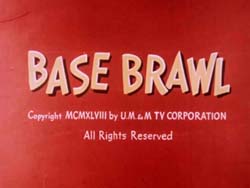 Base Brawl (Famous/Paramount, Screen Song, 1/23/48 – Seymour Kneitel, dir.) – A ton of old gags, liberally borrowed from several studios, punctuate this film. At the local zoo, all the animals are out of their cages, to attend the opening game of the season at Zoo Stadiim between the Jungle Jumbos and the Forest All Stars. All the open cages have notes of apology to zoo patrons fastened to the bars, stating they have gone to the game. The monkeys think farthest ahead, including below their sign a bucket fastened to the bars, with additional instructions, “Leave peanuts here.”
Base Brawl (Famous/Paramount, Screen Song, 1/23/48 – Seymour Kneitel, dir.) – A ton of old gags, liberally borrowed from several studios, punctuate this film. At the local zoo, all the animals are out of their cages, to attend the opening game of the season at Zoo Stadiim between the Jungle Jumbos and the Forest All Stars. All the open cages have notes of apology to zoo patrons fastened to the bars, stating they have gone to the game. The monkeys think farthest ahead, including below their sign a bucket fastened to the bars, with additional instructions, “Leave peanuts here.”
All Star Pee Wee Beaver shapes up a bat for himself, carving one from a raw log with his teeth. Bobo Jumbo (an elephant pitcher, no particular relation to Hobo Bobo) tosses a first pitch which is one of those old right-angle drop balls, ducking under the bat. “Strike one!”, calls a turtle umpire, who has an eyeball peephole drilled within the chest of his shell so he can keep his head retracted and out of danger while performing his duties. A screwball repeats the old gag of drilling a hole through the beaver’s bat, and Pee Wee borrows from Freleng by calling for a bat boy who is an actual live bat. Next, a fireball, borrowed from Goofy, turning the beaver’s new bat into a burnt matchstick. Next batter Gary Goat receives one original pitch – a Hi-Ball, delivered in cocktail glass, with straw! The next pitch finds Gary swinging like a rusty gate, lifting directly from Kneitel’s work on Popeye’s “The Twisker Pitcher:” The third ball is the old slow ball or “floater”, delivered in the usual manner, while the catcher catches up on his reading, from a magazine entitled “Hobo News.” Third batter Stinky Skunk steps up, causing the elephant catcher to don a gas mask. As the pitched ball approaches the plate, it stops in its tracks just ahead of Stinky, develops a nose to sniff the air, then seems to melt in mid-air as if it fainted. Stinky gets a bead on it, and whacks it far into right field. There, a fielder elephant lounges on the grass, reading a comic book. Without even rising, he merely lifts his trunk into the air, nabs the ball before it can go over the fence, then inhales the ball through his trunk, opening his mouth to let the ball roll out into his glove. At the scoreboard, a live goose perched atop the board lays a literal “goose egg”, dropping in place to denote the box score for the All Stars’ half of the inning.
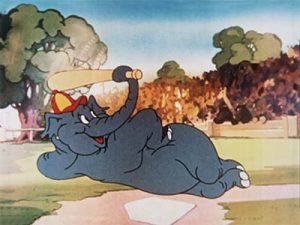 Now the Jumbos come to bat. A fox catcher sends signals to the pitcher via a flashing light with shutters concealed under his chest protector, borrowed from the U.S. Navy. The pitch – and the elephant batter merely stops the ball cold in mid-air by blowing on it with his trunk, then belts it into the infield. A bear advances on the ball as it plows though the infield grass like a lawn mower. The bear dives to stop it, but has the ball escape through his legs, and rises from the ground to find the fur mowed off down the middle of his chest. The elephant is signaled by the base coach to try for third, again using an item from Navy surplus, relaying the signal with a pair of paddles normally used to guide-in planes on an aircraft carrier. The elephant slides into the base, flattening the baseman. The next batter waits comfortably in an easy chair at the plate, and socks the next ball a good one. Let’s steal one from Tex Avery, shall we – as the toothpaste billboard gag from “Batty Baseball” is repeated, knocking out the teeth of a smiling gentleman on the sign. A monkey pitcher has to dive into a trap door inside the mound to avoid getting hit by the next comebacker. A rabbit in the outfield is driven right through the fence in trying to catch the ball, and another homer is scored. The Jumbos go on a rampage, and one of their own operates the scoreboard with the apparatus of an adding machine to chalk up the runs, while the All Stars keep receiving goose eggs. A continuity error has the Jumbos batting in the top of the 7th inning, though they should have been pitching. They are finally called out as a kangaroo calls for the ball but fails to catch it, getting conked on the head. But her offspring in her pouch makes the catch. (We’ve seen that one from Lantz’s “Soft Ball Game”.) The turtle calls the third out on the Jumbos, and is buried in thrown pop bottles by the irate fans. His head rises above the bottles, to yell back, “I said it, and I’m glad!”
Now the Jumbos come to bat. A fox catcher sends signals to the pitcher via a flashing light with shutters concealed under his chest protector, borrowed from the U.S. Navy. The pitch – and the elephant batter merely stops the ball cold in mid-air by blowing on it with his trunk, then belts it into the infield. A bear advances on the ball as it plows though the infield grass like a lawn mower. The bear dives to stop it, but has the ball escape through his legs, and rises from the ground to find the fur mowed off down the middle of his chest. The elephant is signaled by the base coach to try for third, again using an item from Navy surplus, relaying the signal with a pair of paddles normally used to guide-in planes on an aircraft carrier. The elephant slides into the base, flattening the baseman. The next batter waits comfortably in an easy chair at the plate, and socks the next ball a good one. Let’s steal one from Tex Avery, shall we – as the toothpaste billboard gag from “Batty Baseball” is repeated, knocking out the teeth of a smiling gentleman on the sign. A monkey pitcher has to dive into a trap door inside the mound to avoid getting hit by the next comebacker. A rabbit in the outfield is driven right through the fence in trying to catch the ball, and another homer is scored. The Jumbos go on a rampage, and one of their own operates the scoreboard with the apparatus of an adding machine to chalk up the runs, while the All Stars keep receiving goose eggs. A continuity error has the Jumbos batting in the top of the 7th inning, though they should have been pitching. They are finally called out as a kangaroo calls for the ball but fails to catch it, getting conked on the head. But her offspring in her pouch makes the catch. (We’ve seen that one from Lantz’s “Soft Ball Game”.) The turtle calls the third out on the Jumbos, and is buried in thrown pop bottles by the irate fans. His head rises above the bottles, to yell back, “I said it, and I’m glad!”
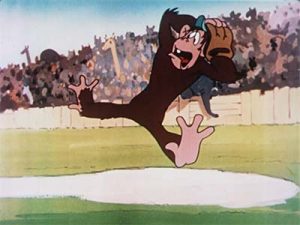 The cartoon breaks for the seventh-inning stretch, and the turtle places a bouncing baseball in the air for us to sing the full version of “Take Me Out To the Ball Game”. (If you don’t know the song, here’s your chance to learn it.) The cartoon ends with the Jumbos pitching, and finding themselves in an unsolvable dilemma, as the All Stars devise a winning strategy with a complete change in the line-up for pinch hitters. Instead of their usual mixed roster of animals, all they send up us mice. Each mouse is so small, the baseball dwarfs it – so no pitch, even ones rolled on the ground, can fit within the mice’s strike zones. The umpire repeatedly calls “Ball. Take your base”. The elephants spend the rest of the afternoon hopelessly rolling balls to the mice, as the rodents circle the bases in a continuous conga line to the accentuated strains of “Three Blind Mice”.
The cartoon breaks for the seventh-inning stretch, and the turtle places a bouncing baseball in the air for us to sing the full version of “Take Me Out To the Ball Game”. (If you don’t know the song, here’s your chance to learn it.) The cartoon ends with the Jumbos pitching, and finding themselves in an unsolvable dilemma, as the All Stars devise a winning strategy with a complete change in the line-up for pinch hitters. Instead of their usual mixed roster of animals, all they send up us mice. Each mouse is so small, the baseball dwarfs it – so no pitch, even ones rolled on the ground, can fit within the mice’s strike zones. The umpire repeatedly calls “Ball. Take your base”. The elephants spend the rest of the afternoon hopelessly rolling balls to the mice, as the rodents circle the bases in a continuous conga line to the accentuated strains of “Three Blind Mice”.
Rather astonishingly, Paramount was desperate for attention for its revived Screen Song series, and submitted this cartoon for consideration as an Academy nominee. It of course failed, by probably a long shot, to make the grade. After all, how could you consider giving it an award? With so much material stolen from so many studios, it’d be like having to award a statue to the entire industry simultaneously.
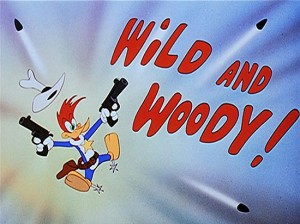 Wild and Woody (Lantz/United Artists, Woody Woodpecker, 12/31/48 – Dick Lundy, dir.) – 1949 was a great year for Lantz animation. Under his new but short-lived association with United Artists, Lantz finally had the budget to produce cartoons up to the quality standards of larger rival studios. Under the direction and supervision of ex-Disney man Dick Lundy, the classic-design Woody became a fully-flexible three-dimensioned character with both moves and personality. Gag-timing was well honed and rapid fire. And Woody finally had an opponent who was worthy of Woody’s cunning and tricks and could give him a run for his money, in the form of the villainous Buzz Buzzard (adapted from Lundy’s Ben Buzzard in Donald Duck’s “The Flying Jalopy”). Woody’s films from this period are among his most fun to watch, and this one is certainly one of the best. Too bad these conditions just were not in the cards to last.
Wild and Woody (Lantz/United Artists, Woody Woodpecker, 12/31/48 – Dick Lundy, dir.) – 1949 was a great year for Lantz animation. Under his new but short-lived association with United Artists, Lantz finally had the budget to produce cartoons up to the quality standards of larger rival studios. Under the direction and supervision of ex-Disney man Dick Lundy, the classic-design Woody became a fully-flexible three-dimensioned character with both moves and personality. Gag-timing was well honed and rapid fire. And Woody finally had an opponent who was worthy of Woody’s cunning and tricks and could give him a run for his money, in the form of the villainous Buzz Buzzard (adapted from Lundy’s Ben Buzzard in Donald Duck’s “The Flying Jalopy”). Woody’s films from this period are among his most fun to watch, and this one is certainly one of the best. Too bad these conditions just were not in the cards to last.
Western gunslinger Buzz Buzzard is so proficient at knocking-off sheriffs, he directs them with his gunfire onto local golf courses, then tallies the number of shots taken to lay them in a hole in the ground as a golf score. Woody, a cowboy drifter, encounters a resulting opening for a new sheriff in the town of Saddle Sore, Arizona (the original one-hearse town), which offers pensions for widows, and double-pay in case of natural death. Woody acquires his tin star, and steps out into the street with teeth clenched in ferocious determination, vowing to find that Buzzard and tear our his gizzard. But Buzz is right there, looking for the new sheriff and challenging his challenge. A streak of cowardice overcomes Woody, who shrinks to appropriate size to hide behind his tin star, and high-tails it to the Pig’s Foot Saloon (Come in and get pickled).
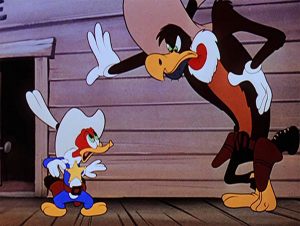 Inside, the band of Hairy James and his Orchestra plays (pun on star ex-Benny Goodman trumpeter Harry James), while a pixilated cowpoke exits the saloon with a bad case of hiccups – Wild Bill Hiccup, by name. Buzz makes an unusual entrance, slipping his slender frame through the crack between the saloon swinging doors without opening them, and announces that he and the new sheriff are going to have a drink together. In a sequence probably remembered by Chuck Jones in the later “Drip-Along Daffy”, and likely inspired by Tex Avery’s saloon gags in “The Shooting of Dan McGoo”, both rivals select “Red-Eye”. Each tries to demonstrate how tough they are, just in opening the bottles. Buzz cracks his open in the middle, depositing its contents in a glass like a cracked egg. Woody merely twists his bottle with his bare hands, wringing out its contents right through the glass.
Inside, the band of Hairy James and his Orchestra plays (pun on star ex-Benny Goodman trumpeter Harry James), while a pixilated cowpoke exits the saloon with a bad case of hiccups – Wild Bill Hiccup, by name. Buzz makes an unusual entrance, slipping his slender frame through the crack between the saloon swinging doors without opening them, and announces that he and the new sheriff are going to have a drink together. In a sequence probably remembered by Chuck Jones in the later “Drip-Along Daffy”, and likely inspired by Tex Avery’s saloon gags in “The Shooting of Dan McGoo”, both rivals select “Red-Eye”. Each tries to demonstrate how tough they are, just in opening the bottles. Buzz cracks his open in the middle, depositing its contents in a glass like a cracked egg. Woody merely twists his bottle with his bare hands, wringing out its contents right through the glass.
Buzz downs his glass in one swift swallow, and nearly gags, as the irises of his eyes spin and morph into a pair of racing cars on a speedway, circling the track inside his head for several laps, then crashing head-on into each other. Now it’s Woody’s turn. One swallow, and Woody’s body turns fiery red from head to toe. His head briefly disconnects from his neck with the force of a thunderbolt strike. His belly inflates, then releases the pent-up force in a small atomic mushroom cloud. Woody transforms into the shape of a missile, and rockets through the saloon roof, crashing into a cloud high above marked “Low ceiling”, and free-falling back to earth, plunging Woody’s body into the base of one of the bar stools.
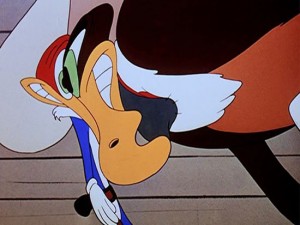 Buzz announces it’s time for the sheriff to draw, and pulls out his own six-shooters. Woody reaches into his holster, but finds it full of something unexpected – a long, long fire hose, which takes forever to pull out onto the floor in a coil. However, at its end is a water valve, which Woody turns on, blasting the buzzard in the face with H2O. Woody runs back for a safer distance between himself and his adversary, as Buzz opens fire. Woody is suddenly seen, garbed in a baseball hat, catcher’s mask, chest protector, and mitt, miraculously catching each of Buzz’s bullets safely in his mitt, and keeping up an encouraging chatter to Buzz similar to one of Friz Freleng’s catchers. Woody amasses all the bullets into a single cannonball the size of a baseball, and flings it at Buzz – right down the buzzard’s throat and into his tail. Buzz is driven back by the force of the throw, and behind him stands Woody, bat in hand. He delivers a sock with the bat upon Buzz’s rear, not only ejecting the cannonball from Buzz’s insides, but turning Buzz’s lower torso inside out, Buzz’s legs emerging from his beak as he runs. Woody finally produces a revolver, and fires away at Buzz, until the clicks from his gun and a built-in gas gauge in the gun’s handle signal “Empty”. Woody dives inside a barrel, while Buzz’s blasts disintegrate all of it save a wooden ring around a knothole.
Buzz announces it’s time for the sheriff to draw, and pulls out his own six-shooters. Woody reaches into his holster, but finds it full of something unexpected – a long, long fire hose, which takes forever to pull out onto the floor in a coil. However, at its end is a water valve, which Woody turns on, blasting the buzzard in the face with H2O. Woody runs back for a safer distance between himself and his adversary, as Buzz opens fire. Woody is suddenly seen, garbed in a baseball hat, catcher’s mask, chest protector, and mitt, miraculously catching each of Buzz’s bullets safely in his mitt, and keeping up an encouraging chatter to Buzz similar to one of Friz Freleng’s catchers. Woody amasses all the bullets into a single cannonball the size of a baseball, and flings it at Buzz – right down the buzzard’s throat and into his tail. Buzz is driven back by the force of the throw, and behind him stands Woody, bat in hand. He delivers a sock with the bat upon Buzz’s rear, not only ejecting the cannonball from Buzz’s insides, but turning Buzz’s lower torso inside out, Buzz’s legs emerging from his beak as he runs. Woody finally produces a revolver, and fires away at Buzz, until the clicks from his gun and a built-in gas gauge in the gun’s handle signal “Empty”. Woody dives inside a barrel, while Buzz’s blasts disintegrate all of it save a wooden ring around a knothole.
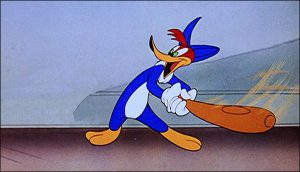 Out of the hole pops Woody, applying a jack-hammer rather than his usual pecking to Buzz’s face. Woody enters a doorway, but is driven back by the barrel of Buzz’s gun in his face. As Buzz advances out of the room, we get a surprise switcheroo – as Woody now exits from the same doorway, right behind him, with a giant-sized revolver planted right in Buzz’s tail section. BLAM!, as Buzz’s tail is denuded. Woody scrambles into a lit pot-bellied stove, somehow avoiding the flame, with a bulge in the stovepipe revealing his efforts to climb to the roof. Buzz follows in a second bulge – but Woody is waiting for him on the roof with a mallet, and smacks Buzz a blow to the head as it emerges from the pipe. Buzz lands inside the stove, and Woody reappears in the room below, tossing into the stove with him a crate of TNT. A powerful blast destroys the stove and any physical trace of its occupant. However, rising from the charred spot comes the transparent soul of Buzz, now seemingly rid of his basic evil, and flitting around the room like a good-natured fairy. The saloon is somehow equipped like a modern hotel, and against one wall we find a pair of elevator doors, with Woody now dressed to play the part of a hotel bellboy. Woody clicks a clicker to signal for the operators of the elevators. One door opens, revealing an operator who is an angel, stating in a heavenly voice. “Going up?” Woody disgustedly slams the door shut – not for this passenger. A more appropriate operator emerges from the second door – the devil himself. “Goin’ down?”, he states in a gruff voice. Woody kicks Buzz’s soul inside, then clicks again for the elevator to close. Once Buzz is gone, Woody breaks into his famous laugh, for the iris out.
Out of the hole pops Woody, applying a jack-hammer rather than his usual pecking to Buzz’s face. Woody enters a doorway, but is driven back by the barrel of Buzz’s gun in his face. As Buzz advances out of the room, we get a surprise switcheroo – as Woody now exits from the same doorway, right behind him, with a giant-sized revolver planted right in Buzz’s tail section. BLAM!, as Buzz’s tail is denuded. Woody scrambles into a lit pot-bellied stove, somehow avoiding the flame, with a bulge in the stovepipe revealing his efforts to climb to the roof. Buzz follows in a second bulge – but Woody is waiting for him on the roof with a mallet, and smacks Buzz a blow to the head as it emerges from the pipe. Buzz lands inside the stove, and Woody reappears in the room below, tossing into the stove with him a crate of TNT. A powerful blast destroys the stove and any physical trace of its occupant. However, rising from the charred spot comes the transparent soul of Buzz, now seemingly rid of his basic evil, and flitting around the room like a good-natured fairy. The saloon is somehow equipped like a modern hotel, and against one wall we find a pair of elevator doors, with Woody now dressed to play the part of a hotel bellboy. Woody clicks a clicker to signal for the operators of the elevators. One door opens, revealing an operator who is an angel, stating in a heavenly voice. “Going up?” Woody disgustedly slams the door shut – not for this passenger. A more appropriate operator emerges from the second door – the devil himself. “Goin’ down?”, he states in a gruff voice. Woody kicks Buzz’s soul inside, then clicks again for the elevator to close. Once Buzz is gone, Woody breaks into his famous laugh, for the iris out.
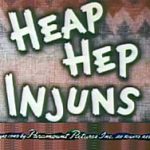 Heap Hep Injuns (Famous/Paramount, Screen Song, 6/30/49 – I. Sparber, dir.) – Another of those one-shot spot gag reels devoted to bad gags and old puns about American Indians, similar to Columbia’s “Wacky Wigwams”, except with a third of its footage taken up with a sing-along of “My Pony Boy”. It lifts verbatim from the Columbia film the gag on tribal names, complete with the Blackfeet, and of course – who else – the Cleveland Indians. Some footage is reused from “The Mild West”, with the driver of a covered wagon averting attack by pilling back the covers, revealing a traveling bargain-basement department store. The film ends with a view of an oil-rich Chief, who resides in a mansion, attended by a half-dozen manservants – but only to escort him to his old teepee in the middle of the living room, which he enters, hanging a sign on the canvas reading “Do not disturb-um”.
Heap Hep Injuns (Famous/Paramount, Screen Song, 6/30/49 – I. Sparber, dir.) – Another of those one-shot spot gag reels devoted to bad gags and old puns about American Indians, similar to Columbia’s “Wacky Wigwams”, except with a third of its footage taken up with a sing-along of “My Pony Boy”. It lifts verbatim from the Columbia film the gag on tribal names, complete with the Blackfeet, and of course – who else – the Cleveland Indians. Some footage is reused from “The Mild West”, with the driver of a covered wagon averting attack by pilling back the covers, revealing a traveling bargain-basement department store. The film ends with a view of an oil-rich Chief, who resides in a mansion, attended by a half-dozen manservants – but only to escort him to his old teepee in the middle of the living room, which he enters, hanging a sign on the canvas reading “Do not disturb-um”.
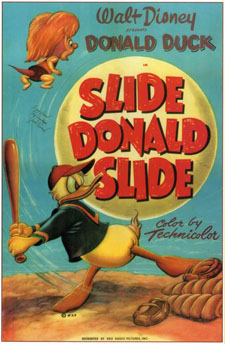 Slide Donald Slide (Disney/RKO, Donald Duck, 11/25/49 – Jack Hannah, dir.) – One of my favorite matchups between Donald Duck and Spike the Bee. A sunny afternoon finds Spike lounging in the flowers in Donald’s garden, while the strains of graceful, soothing waltz music float to his ears from a portable radio playing on a patio table in Donald’s back yard. Spike begins to trip lightly in dance moves atop the visible musical bars that float through the air with the tune, carrying him over to the radio. As the tune ends, Spike switches the channel selector knob on the radio, and we discover his musical preference to be symphonic, as he switches to a classical concert. Mounting an ash tray on the table top, Spike grabs up a match, and uses it as a baton, pretending to conduct the radio orchestra. To make the image complete, he musses up the fuzz on the back of his head, giving him the appropriate “longhair” look of several contemporary conductors. Enter Donald, emerging from the back door of his house, wearing a baseball cap. He plops himself down in a lawn chair next to the table, and opens a newspaper to the sports section, boasting a headline, “World Series Today”. Donald is visibly excited, and reaches for the channel selector, switching to a broadcast of the game. Spike, still lost in his reverie of conducting, is miffed at the abrasive sound of a baseball announcer’s energy-charged voice, and leaves his conducting podium to switch the radio back to the concert broadcast. The stage is set for a battle over the broadcast media.
Slide Donald Slide (Disney/RKO, Donald Duck, 11/25/49 – Jack Hannah, dir.) – One of my favorite matchups between Donald Duck and Spike the Bee. A sunny afternoon finds Spike lounging in the flowers in Donald’s garden, while the strains of graceful, soothing waltz music float to his ears from a portable radio playing on a patio table in Donald’s back yard. Spike begins to trip lightly in dance moves atop the visible musical bars that float through the air with the tune, carrying him over to the radio. As the tune ends, Spike switches the channel selector knob on the radio, and we discover his musical preference to be symphonic, as he switches to a classical concert. Mounting an ash tray on the table top, Spike grabs up a match, and uses it as a baton, pretending to conduct the radio orchestra. To make the image complete, he musses up the fuzz on the back of his head, giving him the appropriate “longhair” look of several contemporary conductors. Enter Donald, emerging from the back door of his house, wearing a baseball cap. He plops himself down in a lawn chair next to the table, and opens a newspaper to the sports section, boasting a headline, “World Series Today”. Donald is visibly excited, and reaches for the channel selector, switching to a broadcast of the game. Spike, still lost in his reverie of conducting, is miffed at the abrasive sound of a baseball announcer’s energy-charged voice, and leaves his conducting podium to switch the radio back to the concert broadcast. The stage is set for a battle over the broadcast media.
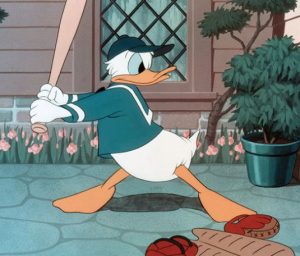 Donald at first cannot figure out what is wrong with the radio, but catches sight of the waving matchstick peeking out around a portion of the ash tray eclipsing a view of Spike. Peering around the tray’s side, Donald finally sees Spike, and while the little bee continues conducting with his eyes closed, Donald gently picks him up in one hand, carries him close to the radio speaker, then abruptly switches channels, shockingly breaking Spike’s mood with a loud umpire call of “Yer OUT!” Spike is shocked off of Donald’s hand, and falls to the table. Donald doubles up in laughter, but himself becomes spellbound by the sports broadcast, as Cy Cobb (wordplay on Ty Cobb, celebrated Hall of Fame center fielder for the Detroit Tigers) comes to the plate. Donald grabs up some baseball gear from his yard, and pantomimes the entire at bat as pitcher, batter, and catcher. Just as the next batter steps up, a click jars Donald out of his fantasy league, and the classical music begins again. Spike is back. This time, Donald gently lifts him by both hair and stinger, then gives him the bum’s rush out of the garden onto the street pavement, slamming the garden gate behind him. Donald also takes no further chances of his return, disconnecting the channel selector knob from the radio, and placing the knob in his shirt pocket. “That’ll fix the little monkey”, Donald mutters.
Donald at first cannot figure out what is wrong with the radio, but catches sight of the waving matchstick peeking out around a portion of the ash tray eclipsing a view of Spike. Peering around the tray’s side, Donald finally sees Spike, and while the little bee continues conducting with his eyes closed, Donald gently picks him up in one hand, carries him close to the radio speaker, then abruptly switches channels, shockingly breaking Spike’s mood with a loud umpire call of “Yer OUT!” Spike is shocked off of Donald’s hand, and falls to the table. Donald doubles up in laughter, but himself becomes spellbound by the sports broadcast, as Cy Cobb (wordplay on Ty Cobb, celebrated Hall of Fame center fielder for the Detroit Tigers) comes to the plate. Donald grabs up some baseball gear from his yard, and pantomimes the entire at bat as pitcher, batter, and catcher. Just as the next batter steps up, a click jars Donald out of his fantasy league, and the classical music begins again. Spike is back. This time, Donald gently lifts him by both hair and stinger, then gives him the bum’s rush out of the garden onto the street pavement, slamming the garden gate behind him. Donald also takes no further chances of his return, disconnecting the channel selector knob from the radio, and placing the knob in his shirt pocket. “That’ll fix the little monkey”, Donald mutters.
Determined Spike quickly finds a gap between boards through which to slip under the garden gate, and returns to the radio. Looking over his shoulder for Donald, Spike reaches for the location where the channel selector should be. The broadcast announcer states “There’s the wind-up”, just as Spike attempts to twist the knob that isn’t there. With nothing to exert his weight upon, Spike falls flat on his face. The bee spots the hole where the knob was removed, and decides to investigate inside the radio. Within, he spots a large metal disc fastened at center to the tuning mechanism, with multiple holes punched in it, resembling an old rotary-dial phone. In the manner of dialing a number, Spike rotates the disc several times, and finally gets his connection, the tuner switching back to the classical broadcast. As the music begins, Spike again gets lost in fantasy, strumming on wires inside the radio as if he were playing a harp.
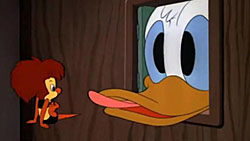 Now Donald is irate, not believing that Spike found a way to switch channels again. He shakes the radio set violently, hearing something rattle around within – then manages to shake Spike out a small hole in the bottom of the radio’s wooden framework. Replacing the channel knob in the radio set, Donald holds Spike firmly in one hand, and questions him. “So, you don’t like baseball?” Spike vigorously shakes his head no. Donald gives him a dose of it anyway, going back into pantomiming the ongoing play of the game, but using Spike for the ball. Donald throws Spike, bunts him, then catches him in a catcher’s mitt as a pop foul. Spike starts to get mad, and uses his stinger tip to rip out the stitching in Donald’s mitt, causing its padding to pop out in a manner roughly resembling the popping of a kernel of popcorn. Spike flies into the air, plucks at his stinger to make sure it is requisitely sharp, then plummets into a dive at Donald, stinger-first. Donald realizes he’s in trouble, and beats a path for his back door, while the voice of the radio announcer states, “This is gonna be close.” Donald slides into his doorway, slamming the door in Spike’s face, as the announcer relays the call, “Safe at home.” Donald quickly opens a peephole in the door, long enough to give Spike the raspberry to taunt him. But Spike realizes he still has the upper hand, knocking on Donald’s window, and pointing to the radio, still outside. Spike flies back to the radio, switching back to the music. “Oh no ya don’t”, says Donald, reflexively emerging from the house. Spike turns, and angrily stomps his feet on the table, buzzing loudly. Donald quickly chickens out, and races back to the safety of his house. He peers out the window, perplexed at how he is to address this dilemma. Spike rubs it in, by briefly switching back to the ball game, long enough for the announcer to state, “A beautiful play…and the score is…”, then switching back to the music, leaving Donald in frustrated suspense as to the game’s progress.
Now Donald is irate, not believing that Spike found a way to switch channels again. He shakes the radio set violently, hearing something rattle around within – then manages to shake Spike out a small hole in the bottom of the radio’s wooden framework. Replacing the channel knob in the radio set, Donald holds Spike firmly in one hand, and questions him. “So, you don’t like baseball?” Spike vigorously shakes his head no. Donald gives him a dose of it anyway, going back into pantomiming the ongoing play of the game, but using Spike for the ball. Donald throws Spike, bunts him, then catches him in a catcher’s mitt as a pop foul. Spike starts to get mad, and uses his stinger tip to rip out the stitching in Donald’s mitt, causing its padding to pop out in a manner roughly resembling the popping of a kernel of popcorn. Spike flies into the air, plucks at his stinger to make sure it is requisitely sharp, then plummets into a dive at Donald, stinger-first. Donald realizes he’s in trouble, and beats a path for his back door, while the voice of the radio announcer states, “This is gonna be close.” Donald slides into his doorway, slamming the door in Spike’s face, as the announcer relays the call, “Safe at home.” Donald quickly opens a peephole in the door, long enough to give Spike the raspberry to taunt him. But Spike realizes he still has the upper hand, knocking on Donald’s window, and pointing to the radio, still outside. Spike flies back to the radio, switching back to the music. “Oh no ya don’t”, says Donald, reflexively emerging from the house. Spike turns, and angrily stomps his feet on the table, buzzing loudly. Donald quickly chickens out, and races back to the safety of his house. He peers out the window, perplexed at how he is to address this dilemma. Spike rubs it in, by briefly switching back to the ball game, long enough for the announcer to state, “A beautiful play…and the score is…”, then switching back to the music, leaving Donald in frustrated suspense as to the game’s progress.
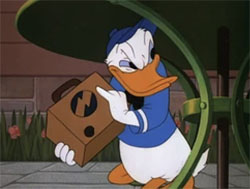 Donald devises a devilish plan. In his garage, he works with tools to fashion a quick but hollow replica of the radio outside. Within, he plants a match fastened to the channel selector knob, a piece of flint for the match to rub against when the knob is turned, and a small stick of dynamite with fuse within the match’s reach. While Spike is again lost in conducting, Donald creeps outside, keeping low below the level of the patio table top. Reaching upwards at the table’s base, Donald pulls a quick switch, replacing his booby-trap radio in place of the real one. Then, holding the real radio below the table, Donald switches the sound to the baseball broadcast. Spike, thinking the sound is coming from the radio he sees, can’t figure out why the game is on again, and reaches for the channel selector to switch back to the music. He activates the dynamite, and incurs the explosive force, landing on the ground with his natual fuzz blackened. Donald is in stitches with laughter, and places the real radio back where it belongs to enjoy the game in peace. Home Run Casey comes to bat with the bases loaded. Donald goes into pantomime again, using a welcome mat in his garden for home plate, and running the bases around a square path in his garden as Casey hits a long one. Spike positions himself in the welcome mat, with his stinger facing the “baseline”, just as Donald goes into a slide for the plate. Donald’s tail collides right into Spike’s stinger, with a painful “YEOW!!” Spike, still all in black, rearranges his frazzled hair into the shape of an umpire’s cap, and gestures, as the announcer simultaneously calls, that Donald is out. Donald, just as Casey in the real game, puts up a heated verbal argument about the play, really laying it into Spike and kicking dirt in his face. Spike ejects Donald from the game, sending him to the showers. Donald obliges by entering a stall shower in his bathroom, and taking a bath. Spike, however, glies in, and latches the shower door shut from the outside. Suddenly, Donald hears from outdoors the classical music once again – and realized he has been duped. However, he can’t get the shower door open to get at Spike. Donald’s angry “Waak”s are heard every time he rattles the shower door, and Spike concludes his conducting chores, by alternating baton waves between the orchestra score and Donald’s quacking, for the end of the symphony. Audience applause rises from the broadcast, and Spike takes a humble bow to his public – then collapses over his podiu,, in total exhaustion, for the iris out. One of only a few Spike cartoons which never saw theatrical reissue – and I’ve always wondered, why not?
Donald devises a devilish plan. In his garage, he works with tools to fashion a quick but hollow replica of the radio outside. Within, he plants a match fastened to the channel selector knob, a piece of flint for the match to rub against when the knob is turned, and a small stick of dynamite with fuse within the match’s reach. While Spike is again lost in conducting, Donald creeps outside, keeping low below the level of the patio table top. Reaching upwards at the table’s base, Donald pulls a quick switch, replacing his booby-trap radio in place of the real one. Then, holding the real radio below the table, Donald switches the sound to the baseball broadcast. Spike, thinking the sound is coming from the radio he sees, can’t figure out why the game is on again, and reaches for the channel selector to switch back to the music. He activates the dynamite, and incurs the explosive force, landing on the ground with his natual fuzz blackened. Donald is in stitches with laughter, and places the real radio back where it belongs to enjoy the game in peace. Home Run Casey comes to bat with the bases loaded. Donald goes into pantomime again, using a welcome mat in his garden for home plate, and running the bases around a square path in his garden as Casey hits a long one. Spike positions himself in the welcome mat, with his stinger facing the “baseline”, just as Donald goes into a slide for the plate. Donald’s tail collides right into Spike’s stinger, with a painful “YEOW!!” Spike, still all in black, rearranges his frazzled hair into the shape of an umpire’s cap, and gestures, as the announcer simultaneously calls, that Donald is out. Donald, just as Casey in the real game, puts up a heated verbal argument about the play, really laying it into Spike and kicking dirt in his face. Spike ejects Donald from the game, sending him to the showers. Donald obliges by entering a stall shower in his bathroom, and taking a bath. Spike, however, glies in, and latches the shower door shut from the outside. Suddenly, Donald hears from outdoors the classical music once again – and realized he has been duped. However, he can’t get the shower door open to get at Spike. Donald’s angry “Waak”s are heard every time he rattles the shower door, and Spike concludes his conducting chores, by alternating baton waves between the orchestra score and Donald’s quacking, for the end of the symphony. Audience applause rises from the broadcast, and Spike takes a humble bow to his public – then collapses over his podiu,, in total exhaustion, for the iris out. One of only a few Spike cartoons which never saw theatrical reissue – and I’ve always wondered, why not?
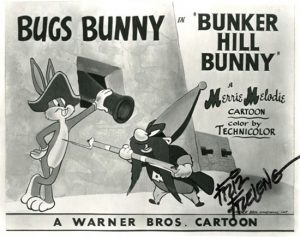 Bunker Hill Bunny (Warner, Bugs Bunny, 9/23/50 – I (Friz) Freleng, dir.) – The chronicle of the unsung Revolutionary War battle of Bagle Heights – a one-on-one confrontation between rival forts, one manned by Sam Von Shmam, the Hessian, the other by Bugs Bunny defending his native soil. Each fort displays a flag, Sam’s stating “They”, and Bugs’s stating “We”. Tiring of firing cannon at each other from a distance, Sam commands himself into a charge, and provides his own marching drum beats as he approaches Bugs’s fort. Of course, he walks straight into a cannon aimed at him inside the fort door. Blasted into a charred gray, Sam beats on his busted drum at double-time retreat tempo. He reactivates his cannons briefly once back behind his own walls to soften up the enemy, then again appears out the door, armed with a bayonet. “Charge!”, he commands. Bugs appears is his own fort doorway, similarly armed with bayonet, and orders an equally loud “Charge!” They advance at full speed in each other’s direction. But instead of engaging in battle, the two combatants pass each other entirely, each running headlong into the other’s fort. The “We” flag is lowered in Bugs’ fort, and replaced by a “They” flag. However, Bugs is replacing Sam’s old “They” flag with a “We”. When Bugs waves Sam a “Yoo-hoo” to wise him up as to what’s been done, Sam orders a “Charge” in the other direction. Bugs does likewise, and the two pass each other again, repeating the same flag ceremonies back at their original forts. Never one to give up trying, Sam charges one more time. Bugs does not advance, but waits patiently outside the fort walls. As Sam approaches, Bugs swings the fort door open. Its entrance is now filled by the mouth of a cannon so big, Sam is able to run directly into its barrel. Finding himself surrounded by walls of steel cylinder, Sam changes military tactics. “Retreat!!!” But the cannon goes off before Sam can exit the barrel, sailing him through the air to land back behind his own fort walls.
Bunker Hill Bunny (Warner, Bugs Bunny, 9/23/50 – I (Friz) Freleng, dir.) – The chronicle of the unsung Revolutionary War battle of Bagle Heights – a one-on-one confrontation between rival forts, one manned by Sam Von Shmam, the Hessian, the other by Bugs Bunny defending his native soil. Each fort displays a flag, Sam’s stating “They”, and Bugs’s stating “We”. Tiring of firing cannon at each other from a distance, Sam commands himself into a charge, and provides his own marching drum beats as he approaches Bugs’s fort. Of course, he walks straight into a cannon aimed at him inside the fort door. Blasted into a charred gray, Sam beats on his busted drum at double-time retreat tempo. He reactivates his cannons briefly once back behind his own walls to soften up the enemy, then again appears out the door, armed with a bayonet. “Charge!”, he commands. Bugs appears is his own fort doorway, similarly armed with bayonet, and orders an equally loud “Charge!” They advance at full speed in each other’s direction. But instead of engaging in battle, the two combatants pass each other entirely, each running headlong into the other’s fort. The “We” flag is lowered in Bugs’ fort, and replaced by a “They” flag. However, Bugs is replacing Sam’s old “They” flag with a “We”. When Bugs waves Sam a “Yoo-hoo” to wise him up as to what’s been done, Sam orders a “Charge” in the other direction. Bugs does likewise, and the two pass each other again, repeating the same flag ceremonies back at their original forts. Never one to give up trying, Sam charges one more time. Bugs does not advance, but waits patiently outside the fort walls. As Sam approaches, Bugs swings the fort door open. Its entrance is now filled by the mouth of a cannon so big, Sam is able to run directly into its barrel. Finding himself surrounded by walls of steel cylinder, Sam changes military tactics. “Retreat!!!” But the cannon goes off before Sam can exit the barrel, sailing him through the air to land back behind his own fort walls.
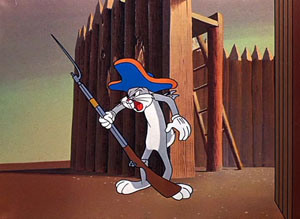 Sam rearms with a cartoon black bomb, and hurls it at Bugs’s fort. Bugs quick-changes into a baseball uniform, and slugs the bomb a mighty clout. Although a Hessian, Sam has great familiarity with the national game, pulling from his coat pocket a baseball mitt and rearing back into his fort, yelling. “I got it. I got It.” The bomb falls within the fort, a huge blast rising from its walls – and the “They” flag is replaced with a new one reading, “He got it.” Sam vows to blast the fur bearing critter to smithereenies, and fires a cannonball at Bugs. On the wall of his fort, Bugs positions another cannon, and catches the cannonball directly inside the barrel. Repeating the stream of chatter of a baseball catcher familiar to Freleng cartoons, Bugs cheers on Sam to show him what he’s got on the old cannonball, and fires the cannonball right back into Sam’s weapon. These cannon are quite remarkable for their day, in that, while both have already been fired, neither has to be refilled with gunpowder in order to be readied again – instead, all you do is pull a firing pin, and the gun goes off! So Sam shoots the same cannonball at Bugs again, and Bugs makes another remarkable catch, then hits the mark on the return shot, right back into Sam’s barrel. But now the added twist. As Sam pulls his firing pin again, a new object is launched by Bugs into his cannon barrel – a giant cork. Sam runs around front to pull he cork out – and takes the whole brunt of the built-up cannon shot inside, leaving him frazzled as usual.
Sam rearms with a cartoon black bomb, and hurls it at Bugs’s fort. Bugs quick-changes into a baseball uniform, and slugs the bomb a mighty clout. Although a Hessian, Sam has great familiarity with the national game, pulling from his coat pocket a baseball mitt and rearing back into his fort, yelling. “I got it. I got It.” The bomb falls within the fort, a huge blast rising from its walls – and the “They” flag is replaced with a new one reading, “He got it.” Sam vows to blast the fur bearing critter to smithereenies, and fires a cannonball at Bugs. On the wall of his fort, Bugs positions another cannon, and catches the cannonball directly inside the barrel. Repeating the stream of chatter of a baseball catcher familiar to Freleng cartoons, Bugs cheers on Sam to show him what he’s got on the old cannonball, and fires the cannonball right back into Sam’s weapon. These cannon are quite remarkable for their day, in that, while both have already been fired, neither has to be refilled with gunpowder in order to be readied again – instead, all you do is pull a firing pin, and the gun goes off! So Sam shoots the same cannonball at Bugs again, and Bugs makes another remarkable catch, then hits the mark on the return shot, right back into Sam’s barrel. But now the added twist. As Sam pulls his firing pin again, a new object is launched by Bugs into his cannon barrel – a giant cork. Sam runs around front to pull he cork out – and takes the whole brunt of the built-up cannon shot inside, leaving him frazzled as usual.
 The film ends with possibly the earliest use of the gunpowder trail gag. Sam sneaks a barrel of gunpowder connected to a long fuse over to Bugs’s fort wall – not realizing the barrel has a hole in it, which is dumping powder into the back of Sam’s pants. Sam’s trousers also are not leakproof, so as Sam returns to his fort, he leaves a trail of powder on the ground behind him. Back within his own walls, Sam lights the fuse. The fuse burns all the way to Bugs’s wall – where Bugs sits nonchalantly on the powder keg, and snuffs out the fuse one inch shy of entering the powder barrel. He then tosses a match on the trail of powder Sam has left behind, which burns all the way back to Sam. Sam runs, but continues to leave a powder trail wherever he goes, and is even followed by it up a tree, where the explosion leaves Sam as the only foliage left hanging from the branches. Sam concludes to the audience. “I’m a Hessian without no aggression. If you can’t beat ‘em, join ‘em.” The final shot has Sam, with bandaged head, beating his drum, while Bugs, in his minuteman hat, plays fife, for a “Spirit of ‘76? iris out – just a bit late for the recent 4th of July.
The film ends with possibly the earliest use of the gunpowder trail gag. Sam sneaks a barrel of gunpowder connected to a long fuse over to Bugs’s fort wall – not realizing the barrel has a hole in it, which is dumping powder into the back of Sam’s pants. Sam’s trousers also are not leakproof, so as Sam returns to his fort, he leaves a trail of powder on the ground behind him. Back within his own walls, Sam lights the fuse. The fuse burns all the way to Bugs’s wall – where Bugs sits nonchalantly on the powder keg, and snuffs out the fuse one inch shy of entering the powder barrel. He then tosses a match on the trail of powder Sam has left behind, which burns all the way back to Sam. Sam runs, but continues to leave a powder trail wherever he goes, and is even followed by it up a tree, where the explosion leaves Sam as the only foliage left hanging from the branches. Sam concludes to the audience. “I’m a Hessian without no aggression. If you can’t beat ‘em, join ‘em.” The final shot has Sam, with bandaged head, beating his drum, while Bugs, in his minuteman hat, plays fife, for a “Spirit of ‘76? iris out – just a bit late for the recent 4th of July.
• You can watch BUNKER HILL BUNNY (sans titles) on Facebook by CLICKING HERE.
NEXT TIME: A new inning in a new decade.